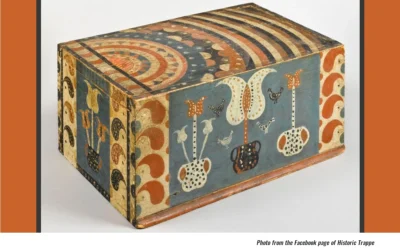TRAPPE PA – Folk art that has made Pennsylvania German creators popular over centuries evolved as they moved west from Pennsylvania’s Perkiomen Valley to Virginia. An exhibit at the Dewees Tavern Museum, 301 W. Main St., explains how “locally distinctive forms of material culture emerged” over time.
Titled “Valley Culture: Constructing Identity Along the Great Wagon Road,” the exhibit is being presented by Historic Trappe with lead support from auctions and appraisals firm Pook & Pook Inc. It runs through August 2025 at the museum.
“This exhibition will help viewers understand how German settlers transformed artifacts of daily life — including fraktur, painted furniture, boxes, and other artifacts — as they settled along the Great Wagon Road,” Historic Trappe explains.
Materials in the exhibit are “drawn from nearly a dozen private collections,” it adds. Among its “exemplary works of American folk art” are:
- An iconic “leaping stag” cupboard, painted by Johannes Spitler of Shenandoah (now Page) County, Virginia;
- “Exuberantly painted boxes” by John Drissell of Bucks County;
- Fraktur by Durs Rudy, Jacob Gottschall, and Andreas Kolb of Montgomery County;
- Painted boxes from the Brothers Valley of Somerset County;
- A newly-discovered chest of drawers from the Mahantongo Valley; and
- Painted furniture and fraktur from the Tulpehocken Valley of Berks and Lebanon counties.
The Historic Trappe Center for Pennsylvania German Studies at the Dewees Tavern is open to the public Saturdays from 10 a.m. to 4 p.m., and Sundays from noon to 4 p.m. Admission costs $10 for adults, $8 for seniors age 65 and older, and for students; $5 for youths ages 6-17. The organization’s members, and children age 5 and younger are admitted free.
Photo from the Facebook page of Historic Trappe
Exhibited at the Nearby Muhlenberg House
Also on exhibit within Historic Trappe is “All Sorts of Chairs and Joiner’s Work: Pennsylvania Furniture from the Dietrich American Foundation. It’s on display on the second-floor gallery of the organization’s nearby Henry Muhlenberg House, 201 Main St. The exhibit features a dozen chairs and six case pieces. Its highlights include:
- A rush-seat chair, retaining the original label of renowned Philadelphia maker William Savery;
- A rare child-size Windsor armchair, branded by Thomas Gilpin;
- A range of Queen Anne and Chippendale chairs with ornate carving;
- An early Philadelphia chest-on-chest; and
- A Chester County desk with line-and-berry inlay.
Admission to this exhibit is included with a guided tour of the Muhlenberg House. Ask its staff about combination admission tickets to other Historic Trappe properties, available at a discount.

 Bird Flu Prompts Changes for Those Hoping to Witness Annual Geese Migration
Bird Flu Prompts Changes for Those Hoping to Witness Annual Geese Migration